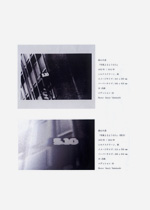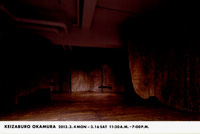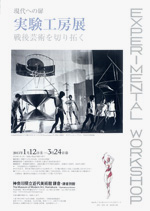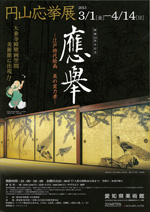 |
Picks is a monthly sampling of Japan's art scene, offering commentary by a variety of reviewers about exhibitions at museums and galleries in recent weeks, with an emphasis on contemporary art by young artists. |
 |
 |
|
|
 |
 |
|
| Daido Moriyama: "Farewell Photography" |
| 16 February - 16 March 2013 |
Taka Ishii Gallery
(Tokyo) |
 |
| This selection of ten images from Moriyama's 1972 collection Farewell Photography is noteworthy for the fact that they are not printed directly onto photographic paper, but silkscreened. Moriyama became interested in the texture and expressive potential of silkscreen in the 1970s and has worked with the medium more than once. Particularly striking is the way that the gray and black tones pick up the distinctively slippery texture of silkscreen. |
|
|
 |
 |
 |
|
| Tricks and Vision to Mono-ha |
| 9 March - 6 April 2013 |
Tokyo Gallery
(Tokyo) |
 |
| Tricks and Vision was a seminal 1968 art exhibition credited with launching the Mono-ha movement. Artists selected by critics Yusuke Nakahara and Junzo Ishiko -- among them Jiro Takamatsu, Natsuyuki Nakanishi, Masakazu Horiuchi, Etsutomu Kashiwara, Kazuo Okazaki, Yoshinori Suzuki, and Nobuo Sekine -- displayed their work at two venues, Tokyo Gallery and Muramatsu Gallery. This recent revisitation of that legendary show brought together related works by the same artists or from the same period. |
|
|

|
 |
 |
 |
 |
| Keizaburo Okamura |
| 4 - 16 March 2013 |
Gallery Kobayashi
(Tokyo) |
 |
| One enters a darkened basement room to confront a large mural -- a monochromatic painting of ethereal, Buddha-like faces -- that fills the far wall, flanked by two similar works at somewhat oblique angles to the left and right. The installation thus has the air of a stage set. The screen-like panels are made of wooden boards that resemble the gallery floor in both color and texture. They are also of a size that perfectly fits the dimensions of the space. |
|
|
 |
 |
 |
| Jikken Kobo -- Experimental Workshop |
| 12 January - 24 March 2013 |
|
The Museum of Modern Art, Kamakura & Hayama
(Kanagawa)
|
 |
| Founded in 1951 and active through the fifties, the Experimental Workshop (Jikken Kobo) included artists, musicians, choreographers and poets, with a pronounced emphasis on music. With works that, however seminal, lacked the dramatic visual impact of those by members of the Gutai collective, the group's legacy has been largely overlooked. A highlight of this long-overdue retrospective at the museum's Kamakura Annex was Toshio Matsumoto's film Bicycle in Dream, with special effects by Eiji Tsuburaya of Godzilla and Ultraman fame -- a work that presaged the golden age of effects in Japanese film and television. |
|
|
|
|
|
|
|

|
 |
 |
 |
 |
| Takashi Kawashima: New coast, and a fragment over a woman. |
| 8 March - 7 April 2013 |
G/P Gallery
(Tokyo)
|
 |
| This series by photographer Kawashima, born in 1985 in Miyagi Prefecture, centers around a photograph of two women that he says he found by chance on the tsunami-devastated seashore there just after the March 2011 catastrophe. With the women and his subsequent friendship with them as a common thread interwoven with his own messages to the stricken region, Kawashima has created a masterful installation out of these images. |
|
|
 |
 |
| VOCA: The Vision of Contemporary Art 2013 |
| 15 - 30 March 2013 |
The Ueno Royal Museum
(Tokyo) |
 |
| On the occasion of the competition's 20th anniversary, this year's exhibition was accompanied by a gallery featuring the prizewinners from previous years. A quick perusal revealed what has clearly solidified into a "VOCA style": paintings that are neither abstract nor realist, but rather a pastiche of figurative images emphasizing vivid colors and strong brushwork. To extricate itself from what seems like a rut, it might behoove VOCA to take this opportunity to replace all four of its screening committee members, who have been on board pretty much since the outset. That might open the door to a tad more diversity among the selections. |
|

|
 |
 |
 |
 |
|
| Mika Kitamura: Einmal ist Keinmal / my small fib |
| 20 - 31 March 2013 |
Therme Gallery
(Tokyo)
|
 |
| The German title means "once is never": what happens once may as well have not happened at all. And indeed, Kitamura's camera focuses on what seem like ephemeral trivia -- a crack in a wall, a pool of light, a fuzzy shadow, a potted plant, a person she just happened to meet. But in a transfiguration that can be attributed to Kitamura's photographic genius, these tiny markers of the quotidian somehow acquire an aura of brilliance that draws the eye inexorably to them. |
|
|
 |
 |
 |
| House Vision 2013 Tokyo Exhibition |
| 2 - 24 March 2013 |
Special Venue, Aomi Station, Odaiba
(Tokyo) |
 |
| Erecting seven house-like "pavilions" on an outdoor site in front of Odaiba's Aomi train station, seven architects, artists, and architect groups joined forces with various corporations to present their concepts of "the shape of living." The roster of participants was heavy on big names: Toyo Ito, Sou Fujimoto, Riken Yamamoto, Hiroshi Sugimoto, Shigeru Ban, Real Tokyo Estate, and Yuri Naruse and Jun Inokuma. Exhibition director Kenya Hara declared that "aesthetics are a Japanese resource, of which the house is a manifestation." |
|
|
|
|
|
|
 |
 |
| Natsumi Hayashi: Today's Levitation |
| 26 - 31 March 2013 |
Spiral Garden
(Tokyo) |
 |
| Through the Web and social networking sites, Hayashi has gained a global audience for her ongoing series of photos of herself floating nonchalantly in midair, an image that may be on the way to becoming something of an icon for our times. Of the new works introduced in this show, a particularly compelling shot is one taken at a sewing factory in Bien Hoa, Vietnam. The skillful posing and overall composition suggest an evolution in her style beyond its "photo diary" format to date. In both ideas and presentation, Hayashi appears to be advancing toward new levels of maturity and perfection. |
|
 |
 |
 |
| Maruyama Okyo Exhibition |
| 1 March - 14 April 12013 |
Aichi Prefectural Museum of Art
(Aichi) |
 |
| Viewing the 90-odd works by the renowned Edo-era artist on display here, one found it hard to believe they were all by the same individual. Okyo (1733-95) was a master of many styles, including those imported from the west. He was particularly adept at applying trompe-l'oeil and megane-e three-dimensional techniques to his panel and screen paintings, taking full advantage of their zig-zag layout. The exhibition also did a nice job of showcasing the relationship between these works and their surrounding space. |
|
|
|
|
 |
|